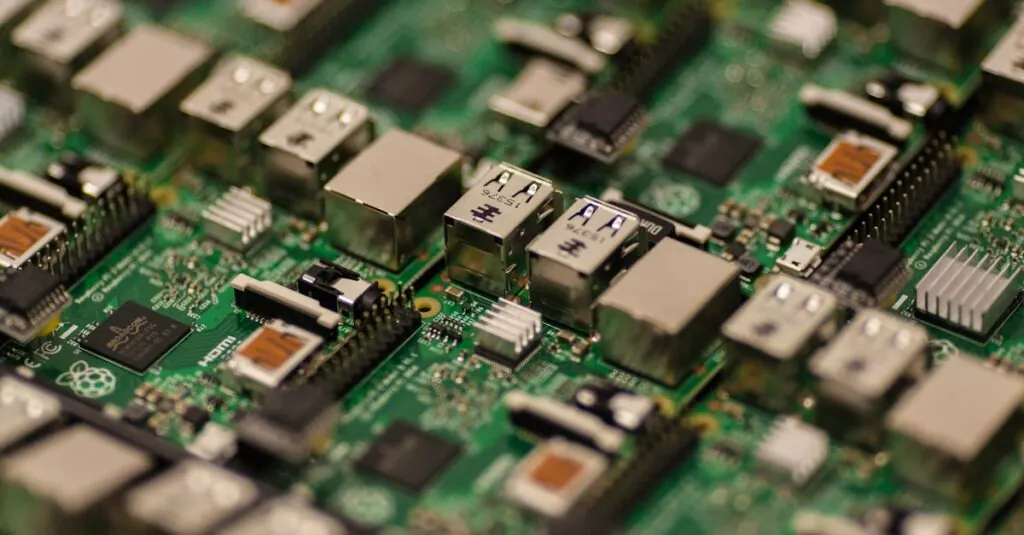Table of Contents
ToggleIn today’s fast-paced world, networking isn’t just a buzzword; it’s a survival skill. Imagine trying to navigate a jungle without a map—confusing, right? That’s what it feels like without a solid networking strategy. Whether you’re a seasoned professional or just starting out, mastering the basics of networking can open doors you didn’t even know existed.
Understanding Networking Basics
Networking involves establishing and nurturing professional relationships. These connections can foster collaboration, provide resources, and open doors to new opportunities.
What Is Networking?
Networking entails building relationships for mutual benefit in professional contexts. It encompasses exchanging information, sharing resources, and seeking advice from peers in similar fields. Professionals often attend events to meet potential contacts and strengthen existing relationships. Conversations that arise can lead to partnerships, job referrals, and mentorship opportunities. Practicing networking can benefit individuals across career stages, enhancing their knowledge and skill sets.
Importance of Networking
Networking plays a crucial role in career advancement and personal growth. It creates a foundation for forming alliances that can lead to unexpected job opportunities. Effective networking can provide access to valuable insights and industry trends. Statistics show that up to 85% of jobs are filled through networking. Having a solid network not only increases visibility but also boosts confidence in navigating career transitions. Engaging with others expands perspectives and fosters an environment of collaboration.
Types of Networks
Networks play a crucial role in connectivity and communication. Understanding different types of networks helps enhance professional relationships and facilitates efficient resource sharing.
Local Area Network (LAN)
A Local Area Network connects devices within a limited area, such as an office or home. LANs enable high-speed data transfer over short distances, making them ideal for tasks that require shared access to resources like printers and storage. Devices often use Ethernet cables or Wi-Fi to establish connections. Security remains a key consideration, as LANs can be vulnerable to unauthorized access if not properly configured. Through effective management, organizations can improve productivity and collaboration among team members.
Wide Area Network (WAN)
Wide Area Networks extend over larger geographical areas, linking multiple LANs together. They often use leased telecommunication lines to facilitate communication across cities or even countries. WANs enable businesses to connect branch offices and remote employees efficiently. Data transmission across WANs may occur at lower speeds compared to LANs but provides a critical infrastructure for global operations. Companies utilize WAN technologies like MPLS and VPNs to secure data transmission while maintaining connectivity across vast distances.
Wireless Networking
Wireless Networking enables devices to connect without physical cables, utilizing radio waves for communication. Wi-Fi and Bluetooth are popular examples of wireless technologies. This flexibility allows for mobility and convenience, as users can access the network from various locations. Enhanced portability comes with challenges, including security risks such as unauthorized access to networks. Implementing robust encryption methods can mitigate these vulnerabilities, ensuring reliable and secure wireless communication.
Networking Devices
Networking devices are essential components that facilitate communication and data transfer within a network. Understanding these devices enhances connectivity and collaboration in professional environments.
Routers
Routers serve as the gateways between different networks. They forward data packets between networks, ensuring the information reaches its destination. Each router connects to multiple networks, managing traffic and directing data efficiently. Advanced routers come equipped with features such as firewall protection, enabling better security for sensitive information. By analyzing network performance, routers optimize data flow, enhancing overall efficiency.
Switches
Switches connect devices within a Local Area Network (LAN), allowing them to communicate directly. When a device sends data, the switch receives it and forwards it to the appropriate device based on MAC addresses. Each device linked to a switch enjoys a dedicated bandwidth, which improves overall network performance. Managed switches offer advanced features, including VLAN support and traffic monitoring, providing network administrators greater control.
Hubs
Hubs act as simplistic networking devices that connect multiple Ethernet devices. They transmit data packets to all connected devices without analyzing the data’s destination. Due to this broadcasting method, hubs can lead to network collisions, which reduce overall performance. While cheaper and easier to set up than switches, hubs lack the efficiency and intelligence that modern networks require. Using hubs is less common now, as switches provide better data management.
Networking Protocols
Networking protocols are essential for enabling communication within and between networks. They outline rules and conventions for data exchange, ensuring seamless connectivity and information transfer.
TCP/IP Overview
TCP/IP, or Transmission Control Protocol/Internet Protocol, serves as the foundation for internet communication. It divides data into packets, facilitating reliable delivery and reassembly at the destination. TCP ensures data integrity by confirming that all packets reach their intended recipient, while IP handles the addressing and routing of these packets across networks. This two-layer architecture allows diverse devices to communicate effectively.
Common Networking Protocols
Several common networking protocols enhance network functionality. HTTP, or Hypertext Transfer Protocol, supports web browsing by transferring data from servers to clients. FTP, or File Transfer Protocol, enables users to upload and download files between computers. SMTP, or Simple Mail Transfer Protocol, governs email transmission, allowing messages to travel between servers. Each protocol plays a vital role in ensuring efficient communication across various applications.
Conclusion
Mastering networking basics is crucial for anyone looking to thrive in their career. By understanding the various types of networks and the devices that support them, individuals can enhance their ability to communicate effectively. Embracing networking as a strategic tool not only opens doors to new opportunities but also fosters valuable relationships that lead to collaboration and growth.
As the landscape of professional networking continues to evolve, staying informed about protocols and technologies is essential. With a solid networking strategy in place, anyone can navigate the complexities of their professional journey with confidence and purpose.




